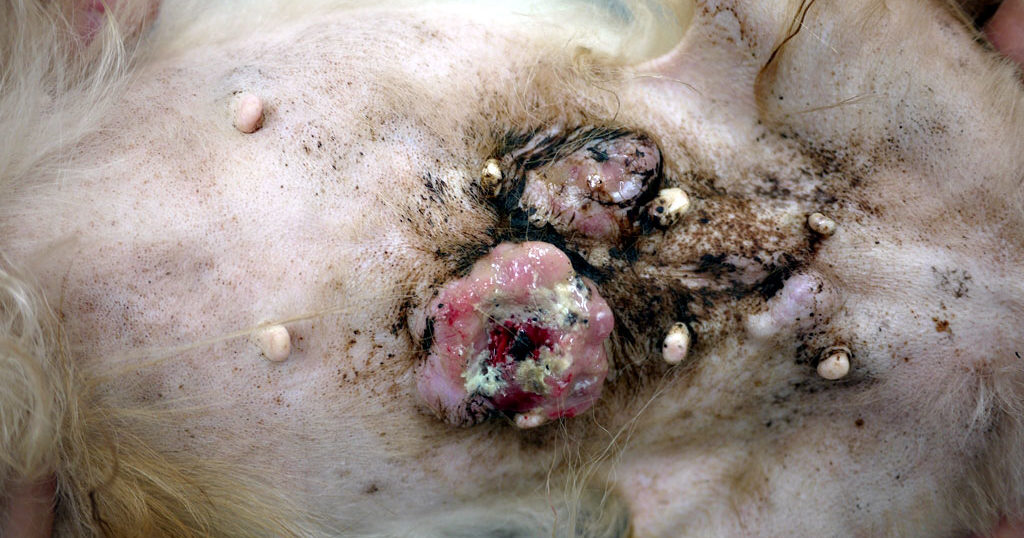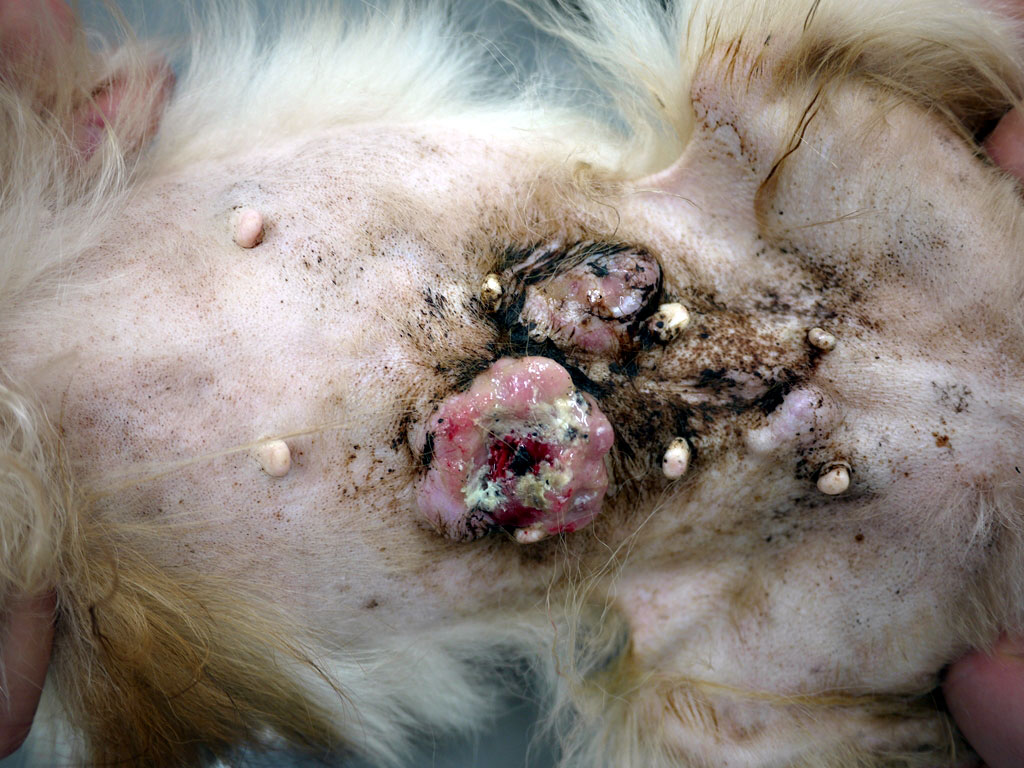Providing information to support your pet’s health>>
目次
- 1 An Example of Tumor Reduction in Dogs Using Cordy
- 2 Treatment Progress
- 2.1 Before Starting the Treatment
- 2.2 One Week After Starting Treatment
- 2.3 Two Weeks After Starting Treatment
- 2.4 Three Weeks After the Start of Treatment
- 2.5 Four Weeks After the Start of Treatment
- 2.6 Five Weeks After the Start of Treatment
- 2.7 Seven Weeks After the Start of Treatment
- 2.8 10 Weeks After the Start of Treatment
- 2.9 11 Weeks After the Start of Treatment
- 2.10 14 Weeks After the Start of Treatment
- 2.11 21 Weeks After the Start of Treatment
- 3 X-ray Images
An Example of Tumor Reduction in Dogs Using Cordy
What is a Mammary Tumor?
Malignant mammary tumors (hereafter, mammary tumors) in dogs and cats are highly recurrent and exceptionally “malignant” cancers. Even if surgically removed, there is a high possibility of recurrence, so surgery does not necessarily mean peace of mind.
Despite being a malignant mammary tumor, combining treatment with Cordy might allow pets to maintain their QOL (quality of life).
Treatment Methods for Mammary Tumors
The mammary tumor was treated with high-dose vitamin C drip therapy and Cordy.
No excision surgery or chemotherapy was performed. Due to the terminal stage, the patient’s condition was very poor, and a treatment plan with minimal damage was devised.
As a surgical procedure, the tumor, which had a modified shape, was tied with a string and was slowly let to fall off. The treatment proved effective, and the pet regained its health, completely controlling the mammary tumor.
Provider: Kamo Animal Hospital (Higashihiroshima)
Combined Treatment: High-dose Vitamin C Drip Therapy
Providing information to support your pet’s health>>
Treatment Progress
Before Starting the Treatment

Papillon, 15 years old, female. The largest tumor was 4.35 cm x 3.71 cm and was self-destructively bleeding. Anemia had appeared due to bleeding. The pet had poor appetite and overall poor condition.
Due to advanced age and poor overall condition, surgery, general anesthesia, and chemotherapy were avoided.
A treatment plan was developed using high-dose vitamin C drip and Cordy. Cordy was administered both orally and sprayed on the affected area. Dosage was 20ml/day.
Image Explanation
The left side of the photo is the head, and the right side is the tail. There are eight nipples, and three tumors. One of the tumors is completely cracked open.
One Week After Starting Treatment

In just one week, tumor reduction was observed. The areas shrank to 58-68% of their original size. Although the height was not measured, Dr. Ito commented that “it looks like it’s becoming flat.” If considered in terms of volume, there was a significant reduction in a short period.
There was also a notable color change in some parts of the tumor, indicating improved blood circulation.
The pet’s condition rapidly improved. At the beginning of the treatment, the pet’s condition was too poor to consume a full dose of Cordy, but after a few days, it was able to consume it. High-dose vitamin C drip was fully administered.
Two Weeks After Starting Treatment

The tumor has not been sutured, but the self-destructing area has started to heal.
The recovery of the pet’s condition is progressing smoothly, and there is a sense of having passed the critical phase.
The blackening of the fur around the affected area is due to blood staining and the application of Cordy’s spray.
Three Weeks After the Start of Treatment
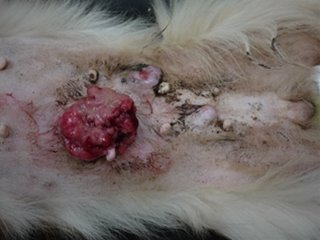
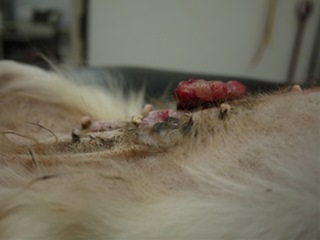
The largest tumor has turned bright red. While the area has expanded, the height has decreased. There is no bleeding, and the situation is not bad.
The shape has changed, and the base has become narrower. It also looks like the normal tissue and the tumor are separating. Dr. Ito describes this shape as “cauliflower-like.”
At Dr. Ito’s suggestion, we decided to tie a string around the base of the “cauliflower” to allow the lesion to detach naturally. It can be done without anesthesia, so it is safe.
The other two tumors seem stable, so we’ll continue to monitor them.
Four Weeks After the Start of Treatment
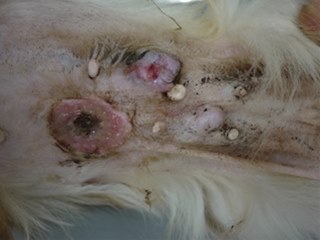
As predicted, the tumor with the string around its base naturally detached. It took 10 days for it to detach. After detachment, there was bleeding from a large nutrient blood vessel, which was stopped using laser treatment.
We decided not to suture the severed area and treated it only with Cordy’s liquid spray. Dr. Ito predicts that it will heal nicely in three weeks.
Five Weeks After the Start of Treatment

The wound from where the lesion detached healed quickly. It is unclear whether any cancer cells remain, but the skin covering the area looks healthy.
The area of the other tumors is gradually expanding. They are smaller than they were before the treatment began, with an area ratio of 45.9% to 63.7%. According to Dr. Ito’s comments, “The remaining tumors also seem to be developing a cauliflower-like shape.”
Expecting a reduction in cancer cells, we reduced the daily oral dose of Cordy to 10 ml.
As the overall condition is good, radical excision surgery is also being considered, but we decided to continue with the current treatment.
Seven Weeks After the Start of Treatment
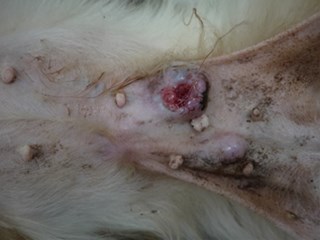

The resected area where the lesion fell off is now completely clean. It might be hard to imagine that there once was a large tumor with its mouth open. The number of nipples has decreased to seven, indicating that treatment has been applied.
The remaining two tumors are showing signs of enlargement and are becoming elevated. According to Dr. Ito’s comments, “It feels as if the body is pushing the cancer cells away.”
After taking this photo, a string was tied at the base of the larger tumor. If successful, it will allow the tumor to fall off naturally again.
10 Weeks After the Start of Treatment

The second tumor, which was tied with a string, also fell off. It took 17 days for it to detach. Although it took more time than the first one, no anesthesia was used, resulting in minimal stress on the body.
A slightly larger detachment wound has formed, but as before, it is planned to treat it by spraying liquid Cordyceps. The wound is expected to heal in about two weeks.
The current supplement intake is 10ml/day. Overall health remains stable.
11 Weeks After the Start of Treatment
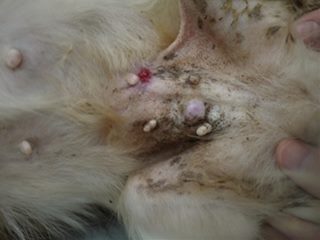
The detachment wound is rapidly being covered with normal skin. Dr. Ito, who is overseeing the treatment, is also surprised at how smoothly the recovery is progressing.
The first detachment wound has already completely healed. The pet’s QoL (condition and appetite) remains good.
The progress has been exceedingly favorable to this point, with no signs of resistance or immune depletion often seen with pharmaceuticals and other supplements.
14 Weeks After the Start of Treatment

The second detachment wound is also now covered with normal skin, and the coloration is healthy.
The last remaining tumor is 16mm-17mm in size. Initially, it measured 16.8mm-14.6mm, so in terms of area, it has expanded.
Rather than growing, it seems to be being expelled from the body. If it protrudes more, it might be possible to ligate and detach it using a string.
21 Weeks After the Start of Treatment

The last remaining tumor has gradually shrunk to 10mm-8mm. The cancer no longer seems to be advancing.
Providing Information to Support Pet Health>>
X-ray Images
At Initial Examination
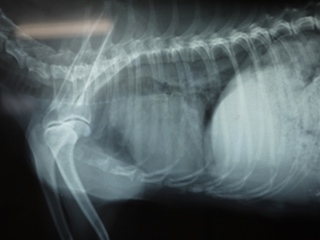
Taken in January 2012. X-ray of the chest of the Papillon at the start of treatment. Mammary cancer (mammary tumor) is known to easily metastasize to the lungs. Dr. Ito has identified several suspicious nodular lesions.
Six Months After the Start of Treatment

Taken on June 5, 2012. Six months have passed since the start of treatment. No suspicious lesions are visible.
Description of the Photo
The left side of the image is the head side, and the right side is the tail side. The leg shown is the front leg. The lungs appear dark as they are filled with air. You can see the heart within the lungs.
The heart appears quite large, but in small dog breeds like Papillons, heart enlargement with age is commonly seen. It is not necessarily a cause for concern.
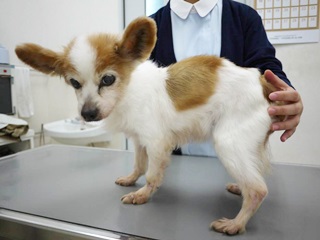
In September 2012, the Papillon passed away peacefully from old age. The photo shows the dog after it had recovered.
Dr. Ito provided the following comments:
“Till the end, the dog kept taking Cordy. I feel that Cordy enabled a true natural death. It was a good passing. The (third) tumor did not change in size at all. I think the immunity boosted by Cordy was able to maintain the condition once the tumor size reduced to some extent.”
At Kamo Animal Hospital, we are exploring ways to treat mammary tumors with minimal burden on animals. In addition to Vitamin C drips, we offer various treatment methods. If you are struggling with cancer treatment in Hiroshima, please consider consulting us.
If you have any questions, please contact us.
監修獣医師:林美彩 所属クリニック:chicoどうぶつ診療所

代替療法と西洋医学、両方の動物病院での勤務経験と多数のコルディの臨床経験をもつ。 モノリス在籍時には、一般的な動物医療(西洋医学)だけでは対応が困難な症例に対して多くの相談を受け、免疫の大切さを痛烈に実感する。
ペットたちの健康維持・改善のためには薬に頼った対処療法だけではなく、「普段の生活環境や食事を見直し、自宅でさまざまなケアを取り入れることで免疫力を維持し、病気にならない体づくりを目指していくことが大切である」という考えを提唱し普及活動に従事している。
所属:

